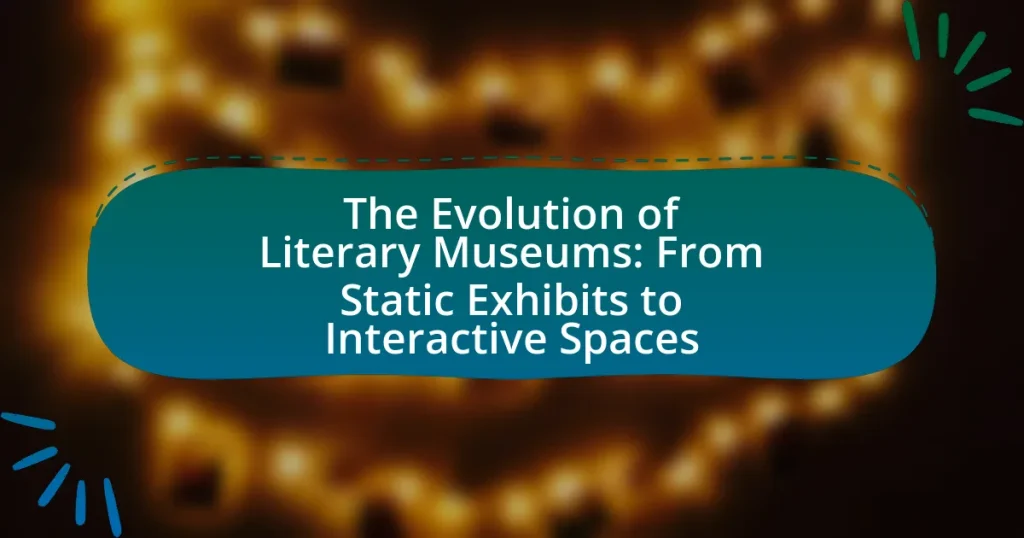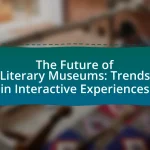Literary museums are institutions focused on preserving, exhibiting, and interpreting literary works and their authors, aiming to educate the public about literature’s significance. This article explores the evolution of literary museums from static displays to dynamic, interactive spaces that enhance visitor engagement through technology and participatory experiences. It examines the characteristics of early literary museums, the changes in their roles throughout the 20th century, and their importance in cultural preservation. Additionally, the article discusses modern features, challenges faced by these institutions, and future trends, emphasizing the role of technology and community involvement in enhancing the visitor experience.
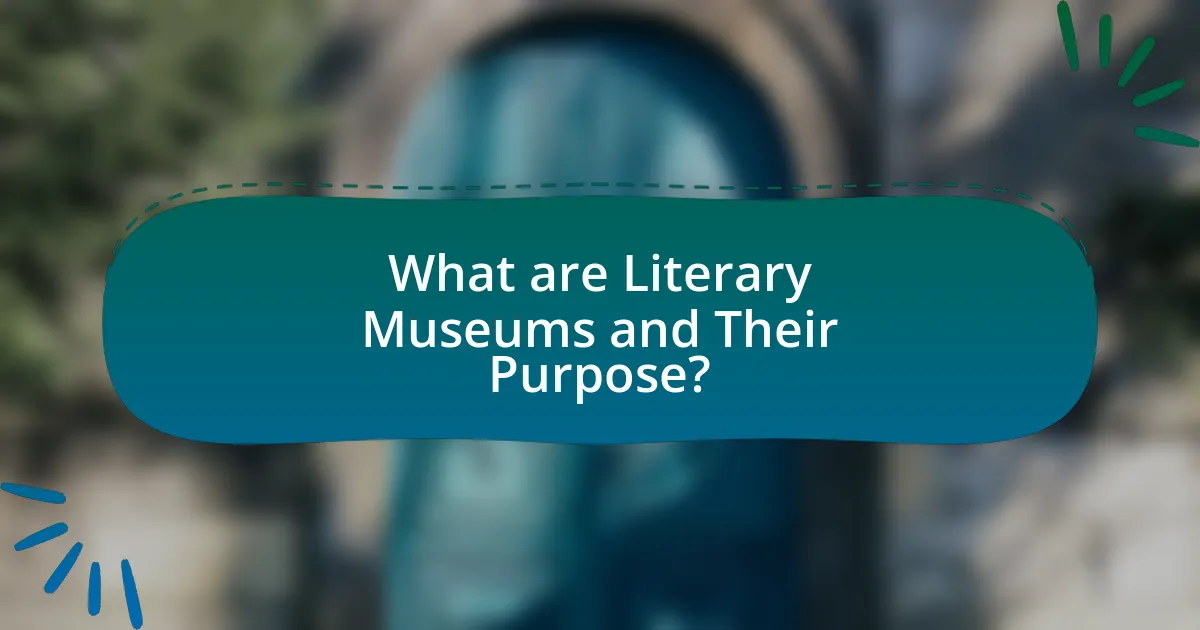
What are Literary Museums and Their Purpose?
Literary museums are institutions dedicated to the preservation, exhibition, and interpretation of literary works, authors, and the cultural contexts surrounding them. Their purpose is to educate the public about the significance of literature and its creators, often showcasing manuscripts, personal artifacts, and interactive exhibits that engage visitors in the literary experience. For instance, the British Library houses original manuscripts from renowned authors, providing insight into their creative processes and historical impact, thereby reinforcing the educational mission of literary museums.
How have Literary Museums evolved over time?
Literary museums have evolved from static exhibits focused primarily on preserving artifacts related to authors and their works to dynamic, interactive spaces that engage visitors through multimedia experiences and participatory activities. Initially, these museums served as repositories for manuscripts, letters, and personal belongings of writers, often emphasizing a traditional display format that limited visitor interaction. Over time, the integration of technology, such as virtual reality and interactive installations, has transformed the visitor experience, allowing for deeper engagement with literary themes and contexts. For instance, the British Library has incorporated digital storytelling and interactive exhibits to attract a broader audience, reflecting a shift towards educational and immersive experiences. This evolution highlights a growing recognition of the importance of accessibility and engagement in cultural institutions, aligning with contemporary trends in museum practices.
What were the characteristics of early literary museums?
Early literary museums were characterized by their focus on preserving and showcasing the works and personal artifacts of notable authors. These institutions primarily featured static exhibits that included manuscripts, letters, and first editions, allowing visitors to engage with the physical remnants of literary history. Additionally, early literary museums often emphasized biographical information about authors, providing context through displays that highlighted their lives and influences. The arrangement of these exhibits was typically linear, guiding visitors through a chronological narrative of the author’s career. This format aimed to educate the public about literary heritage while fostering appreciation for the written word.
How did the role of literary museums change in the 20th century?
The role of literary museums in the 20th century evolved from static exhibits focused primarily on preserving artifacts to dynamic spaces that engage visitors through interactive experiences. This transformation was driven by a growing emphasis on education and public engagement, as museums began to incorporate multimedia presentations, workshops, and events that encouraged active participation. For instance, the establishment of the National Literary Museum in 2003 in New Zealand exemplifies this shift, as it offers interactive displays and educational programs aimed at fostering a deeper understanding of literature. Additionally, the rise of digital technology allowed literary museums to expand their reach and accessibility, further enhancing their role as cultural and educational hubs.
Why are Literary Museums important for cultural preservation?
Literary museums are important for cultural preservation because they safeguard and promote the literary heritage of a society. These institutions collect, curate, and display manuscripts, letters, and artifacts related to authors and their works, ensuring that significant literary contributions are not lost to time. For instance, the British Library houses over 170 million items, including original manuscripts from renowned authors, which serve as vital resources for understanding cultural and historical contexts. By providing educational programs and interactive exhibits, literary museums engage the public and foster appreciation for literature, thereby reinforcing its relevance in contemporary culture.
What role do they play in preserving literary heritage?
Literary museums play a crucial role in preserving literary heritage by curating and showcasing the works, lives, and contexts of authors and their contributions to literature. They collect manuscripts, letters, and artifacts that provide insight into the historical and cultural significance of literary figures, ensuring that their legacies are maintained for future generations. For instance, the British Library houses over 170 million items, including original manuscripts from renowned authors, which serve as primary sources for understanding literary evolution and influence. By facilitating access to these materials, literary museums foster education and appreciation of literary history, thereby safeguarding it against loss or obscurity.
How do they contribute to the understanding of literature?
Literary museums contribute to the understanding of literature by providing immersive experiences that contextualize literary works within their historical and cultural frameworks. These museums often showcase manuscripts, personal artifacts, and multimedia presentations that illustrate the lives of authors and the societal influences on their writing. For example, the British Library houses original manuscripts from authors like Virginia Woolf, allowing visitors to engage directly with the text and its creator’s intentions. This direct interaction fosters a deeper appreciation and comprehension of literary themes, styles, and the evolution of language over time.
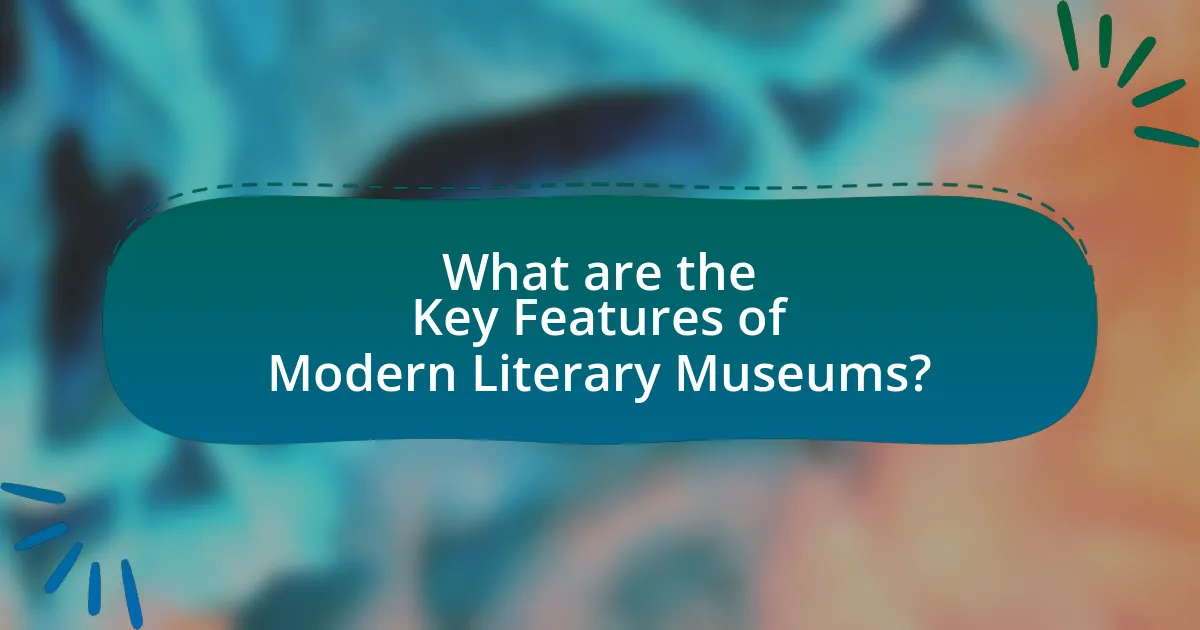
What are the Key Features of Modern Literary Museums?
Modern literary museums feature interactive exhibits, digital technology integration, and immersive storytelling. These elements enhance visitor engagement by allowing them to experience literature in dynamic ways. For instance, many modern literary museums utilize augmented reality to bring texts to life, enabling visitors to interact with characters and settings. Additionally, they often include multimedia presentations, such as audio recordings of authors reading their works, which provide deeper insights into the literary context. Furthermore, modern literary museums frequently host events, workshops, and author talks, fostering a community around literature and encouraging active participation. This evolution from static displays to interactive experiences reflects a broader trend in museum design aimed at enhancing visitor involvement and education.
How do interactive spaces enhance visitor engagement?
Interactive spaces enhance visitor engagement by providing immersive experiences that encourage active participation. These environments allow visitors to interact with exhibits through touch, technology, and collaborative activities, which fosters a deeper emotional connection to the content. Research indicates that interactive elements can increase retention of information by up to 75%, compared to traditional static displays, as they stimulate multiple senses and promote exploration. This engagement is further supported by studies showing that visitors are more likely to share their experiences and return for future visits when they have participated in interactive activities.
What technologies are commonly used in modern literary museums?
Modern literary museums commonly utilize technologies such as augmented reality (AR), virtual reality (VR), interactive touchscreens, and multimedia installations. These technologies enhance visitor engagement by providing immersive experiences that bring literary works and authors’ lives to life. For instance, AR applications allow visitors to interact with exhibits through their smartphones, while VR experiences can transport them into the settings of famous literary works. Interactive touchscreens often feature digital archives and educational content, enabling deeper exploration of literary themes and historical contexts. Multimedia installations combine audio, video, and visual elements to create dynamic storytelling environments, making literature more accessible and engaging for diverse audiences.
How do interactive exhibits differ from static displays?
Interactive exhibits engage visitors through participation and hands-on experiences, while static displays present information in a fixed format without visitor interaction. Interactive exhibits often utilize technology, such as touch screens or augmented reality, to create immersive experiences that encourage exploration and learning, whereas static displays rely on traditional methods like text panels and artifacts to convey information. Research indicates that interactive experiences can enhance retention and understanding, as evidenced by studies showing that visitors to interactive exhibits demonstrate higher engagement levels and recall of information compared to those viewing static displays.
What types of programs do modern literary museums offer?
Modern literary museums offer a variety of programs including author readings, workshops, educational tours, and interactive exhibits. These programs are designed to engage visitors with literature and the creative process, often featuring renowned authors and literary scholars. For instance, many museums host events where authors discuss their works, providing insights into their writing processes. Additionally, workshops allow participants to develop their own writing skills, while educational tours often include guided experiences that highlight significant literary figures and movements. Interactive exhibits further enhance visitor engagement by allowing them to explore literature through multimedia presentations and hands-on activities, reflecting the shift from traditional static displays to dynamic, participatory experiences.
How do educational programs benefit visitors?
Educational programs benefit visitors by enhancing their understanding and appreciation of literary works and authors. These programs provide interactive experiences that engage visitors in learning, allowing them to explore themes, historical contexts, and the creative processes behind literature. For instance, studies show that interactive educational initiatives in museums can increase visitor retention of information by up to 60%, compared to traditional static exhibits. This engagement fosters a deeper connection to the material, making literature more accessible and relevant to diverse audiences.
What role do author events and readings play in the museum experience?
Author events and readings enhance the museum experience by fostering engagement and creating a dynamic atmosphere. These events allow visitors to connect with authors, deepening their understanding of literary works and the context in which they were created. For instance, literary museums that host readings often report increased visitor attendance and participation, as these activities transform static exhibits into interactive experiences. Research indicates that such events can lead to a 30% increase in visitor satisfaction, as they provide opportunities for dialogue and personal interaction with literature.
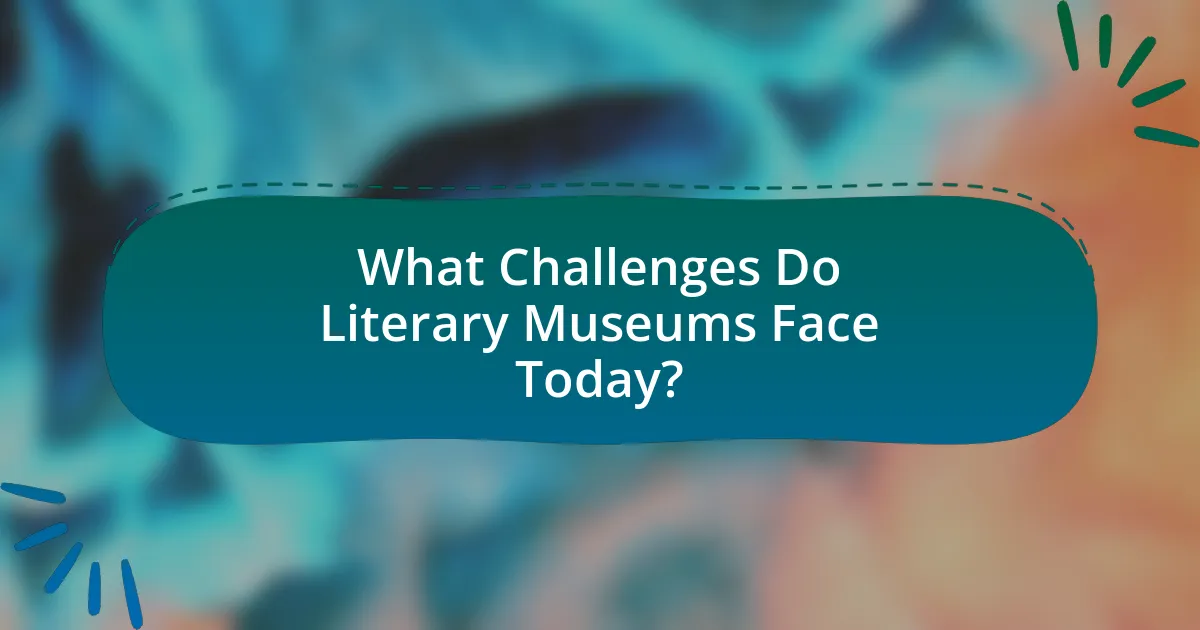
What Challenges Do Literary Museums Face Today?
Literary museums today face challenges such as declining visitor numbers, funding constraints, and the need to adapt to digital advancements. Visitor engagement has decreased, with many museums reporting a drop in attendance due to competition from digital media and changing leisure habits. Financially, many literary museums struggle with limited budgets, which affects their ability to maintain exhibits and develop new programs. Additionally, the shift towards interactive and digital experiences requires museums to invest in technology and staff training, which can be a significant hurdle. These challenges necessitate innovative strategies to attract and retain audiences while ensuring financial sustainability.
How do funding and resources impact literary museums?
Funding and resources significantly impact literary museums by determining their operational capabilities, exhibit quality, and educational outreach. Adequate funding allows literary museums to curate diverse and engaging exhibits, maintain collections, and invest in technology that enhances visitor experiences. For instance, the National Museum of American Literature in Washington, D.C., has utilized grants to develop interactive displays that attract a wider audience, demonstrating how financial support directly correlates with innovation in museum offerings. Additionally, resources enable literary museums to host events, workshops, and educational programs, fostering community engagement and promoting literacy. Without sufficient funding, many literary museums struggle to sustain their operations, limiting their ability to evolve from static exhibits to dynamic, interactive spaces that reflect contemporary literary culture.
What strategies can museums employ to secure funding?
Museums can employ diverse strategies to secure funding, including grant applications, corporate sponsorships, and community fundraising initiatives. Grant applications allow museums to access public and private funds specifically allocated for cultural and educational projects, with organizations like the National Endowment for the Arts providing millions in grants annually. Corporate sponsorships can enhance financial support while offering businesses marketing opportunities, as seen in partnerships between museums and companies like Bank of America, which has funded various exhibitions. Community fundraising initiatives, such as membership drives and crowdfunding campaigns, engage local supporters and can generate significant revenue, evidenced by the success of platforms like Kickstarter, which has funded numerous art projects.
How do economic factors influence visitor attendance?
Economic factors significantly influence visitor attendance by affecting disposable income and overall economic conditions. When the economy is strong, individuals typically have more disposable income, leading to increased spending on leisure activities, including visits to literary museums. Conversely, during economic downturns, reduced disposable income can result in decreased attendance as potential visitors prioritize essential expenses over entertainment. For instance, data from the National Endowment for the Arts indicates that during the 2008 financial crisis, attendance at cultural institutions, including museums, dropped by approximately 20%. This correlation demonstrates how economic stability directly impacts the number of visitors to literary museums.
What are the future trends for Literary Museums?
Future trends for literary museums include the integration of technology, such as virtual reality and augmented reality, to create immersive experiences for visitors. These advancements allow museums to present literary works in dynamic ways, enhancing engagement and understanding. Additionally, there is a growing emphasis on interactive exhibits that encourage visitor participation, fostering a deeper connection with the literature and its authors. Collaborative programming with local communities and educational institutions is also on the rise, aiming to make literary museums more accessible and relevant to diverse audiences. This shift reflects a broader trend towards experiential learning and community involvement in cultural institutions.
How might technology further transform the museum experience?
Technology might further transform the museum experience by integrating augmented reality (AR) and virtual reality (VR) to create immersive environments. These technologies allow visitors to engage with exhibits in a dynamic way, enhancing understanding and retention of information. For instance, museums like the British Museum have implemented AR applications that enable users to visualize artifacts in their original contexts, providing a richer narrative. Additionally, interactive touchscreens and mobile applications can offer personalized tours and educational content, catering to diverse learning styles. Research indicates that interactive experiences can increase visitor engagement by up to 50%, demonstrating the potential of technology to revolutionize how museums communicate their stories.
What role will community involvement play in the evolution of literary museums?
Community involvement will be crucial in the evolution of literary museums by transforming them into dynamic, interactive spaces that reflect local culture and narratives. Engaging the community allows literary museums to curate exhibits that resonate with the public, fostering a sense of ownership and relevance. For instance, museums that incorporate local authors’ works or host community-led events can attract diverse audiences, enhancing visitor engagement and participation. Research indicates that museums with strong community ties see increased attendance and visitor satisfaction, as evidenced by the American Alliance of Museums, which highlights that community-driven initiatives lead to more meaningful experiences for visitors.
What best practices can enhance the visitor experience in Literary Museums?
To enhance the visitor experience in Literary Museums, implementing interactive exhibits is essential. Interactive exhibits engage visitors by allowing them to participate in the storytelling process, which has been shown to increase retention and enjoyment. For instance, the British Library’s “Treasures” gallery uses touchscreens and multimedia displays to provide deeper insights into literary works, resulting in higher visitor satisfaction ratings. Additionally, offering guided tours led by knowledgeable staff can personalize the experience, as evidenced by the success of the Hemingway Home and Museum, where guided tours significantly boost visitor engagement and understanding of the author’s context. Finally, incorporating technology such as augmented reality can create immersive experiences, as seen in the Charles Dickens Museum, where visitors can visualize scenes from Dickens’ works, enhancing their overall experience.
